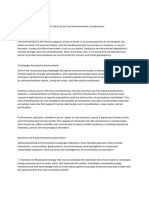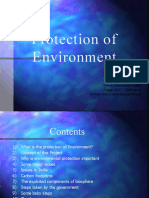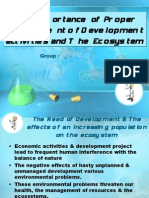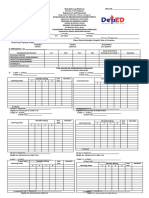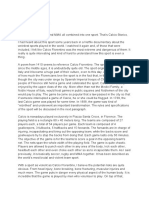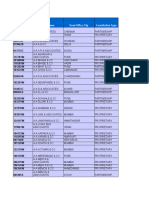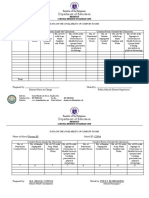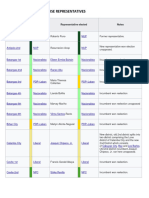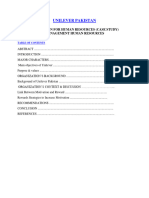1.
Air Pollution: Air pollution refers to the contamination of the air by harmful substances such as
gases, dust, and smoke. These pollutants disrupt the natural composition of the atmosphere and cause
serious health and environmental issues.
Causes of Air Pollution:
i. Burning Fossil Fuels: Combustion of coal, oil, and gas releases sulfur dioxide (SO₂) and
carbon monoxide (CO).
ii. Automobiles: Vehicle emissions like nitrogen oxides (NOₓ), carbon monoxide (CO), and
particulate matter (PM) contribute to poor air quality.
iii. Agricultural Activities: Fertilizers and livestock waste release ammonia (NH₃) and other
pollutants.
iv. Industrial Emissions: Factories emit sulphur dioxide (SO₂), nitrogen oxides (NOₓ), and
volatile organic compounds (VOCs), harming air quality.
v. Mining and Domestic Sources: Mining activities release dust and chemicals, while
household activities like burning fuels also degrade air quality.
Effects of Air Pollution:
i. Health Risks: Exposure to polluted air causes respiratory issues (e.g., asthma),
cardiovascular diseases, and increases cancer risks.
ii. Global Warming: Greenhouse gases from pollution contribute to global warming, leading to
rising sea levels and glacier melting.
iii. Acid Rain and Ozone Depletion: Pollutants cause acid rain, damaging ecosystems, and
deplete the ozone layer, exposing humans to harmful UV rays.
iv. Impact on Wildlife: Air pollution disrupts ecosystems, harms aquatic life, and forces animals
to abandon their habitats.
2. Biodiversity in India: Biodiversity refers to the variety and variability of life forms on Earth,
including plants, animals, and microorganisms. It is crucial for sustaining life and providing resources
like food, fuel, and medicine. Biodiversity contributes to the stability and functioning of ecosystems,
ensuring the survival of species and maintaining ecological balance.
Conservation in India: India is home to a rich diversity of species and ecosystems. Conservation
efforts are vital to protect this biodiversity. The government has initiated several programs, such as
Project Tiger and Project Elephant, which focus on conserving endangered species like tigers and
elephants in their natural habitats. National Parks and Wildlife Sanctuaries serve as protected areas
to ensure the survival of species and their habitats.
Conservation Measures:
i. In-situ Conservation: Involves protecting species in their natural habitats. This includes the
establishment of National Parks and Wildlife Sanctuaries.
ii. Ex-situ Conservation: This includes efforts like zoos, botanical gardens, and gene banks to
conserve species outside their natural habitats.
iii. Public Awareness: Educating the public on the importance of biodiversity and conservation
is essential for the success of conservation programs.
iv. Legal Protections: The government enforces laws to prevent illegal hunting and poaching,
and to regulate the trade of endangered species.
�Challenges & Measures: India faces challenges like habitat destruction, poaching, and the effects of
climate change. To address these challenges, there is a focus on sustainable development practices,
reducing deforestation, and strengthening conservation laws to ensure the survival of biodiversity for
future generations.
3. Sustainable Development: Sustainable development refers to the process of meeting the
needs of the present generation without compromising the ability of future generations to
meet their own needs. It emphasizes the balance between economic growth, environmental
protection, and social well-being to ensure long-term prosperity for all.
Key areas of focus include:
Resource Conservation: Sustainable development encourages the efficient use of
resources such as water, energy, and raw materials to prevent their depletion.
Renewable Energy: Transitioning from fossil fuels to renewable energy sources like
solar, wind, and hydroelectric power is essential to reduce environmental damage and
promote long-term sustainability.
Waste Management: Proper waste management through reduction, recycling, and reuse
helps mitigate pollution and conserve resources.
Sustainable Agriculture: Encouraging farming practices that protect soil health, water
quality, and biodiversity while ensuring food security.
Despite its importance, sustainable development faces challenges like population growth, climate
change, and inequality in resource distribution. Addressing these challenges requires global
collaboration, technological innovation, and policy reforms. Sustainable development is crucial for a
liveable planet, ensuring a healthy environment, equitable social systems, and economic stability for
future generations.
4. Water Conservation Approaches: Water conservation is the practice of using water efficiently to
reduce unnecessary usage and protect water resources. It is essential for ensuring the availability of
fresh water for future generations, especially in areas facing water scarcity. Various approaches to
water conservation include:
1. Rainwater Harvesting: This involves collecting and storing rainwater for future use. It helps
reduce dependency on groundwater and surface water, especially in urban areas. Roof-top
rainwater harvesting systems are a common and effective method.
2. Efficient Irrigation Techniques: Traditional irrigation methods can waste large amounts of
water. Techniques such as drip irrigation and sprinkler systems ensure that water is directed
precisely to plant roots, minimizing water loss through evaporation or runoff.
3. Water Recycling and Reuse: Recycling wastewater for non-potable uses, such as irrigation,
industrial processes, or flushing toilets, reduces the demand for fresh water. In many
industries, water reuse can cut costs and conserve water at the same time.
4. Public Awareness Campaigns: Educating communities on the importance of water
conservation and how to use water wisely can lead to better water-saving practices, such as
using water-efficient appliances, fixing leaks, and reducing daily water consumption.
5. Desalination: In coastal regions, desalination plants can convert seawater into fresh water.
While energy-intensive, desalination provides an alternative water source, especially for arid
regions.
Through these approaches, water conservation can help manage this vital resource more sustainably,
ensuring its availability for both current and future generations.
�1. Explain the concept of natural resources and analyse the role of an individual in the
conservation of resources.
Natural Resources: Natural resources are materials and components that occur naturally in the
environment and are utilized by humans for survival and development. These resources include air,
water, minerals, forests, and wildlife, among others. They are essential for sustaining life on Earth and
supporting human activities. Natural resources can be classified into two categories: renewable (e.g.,
sunlight, wind, water) and non-renewable (e.g., fossil fuels, minerals).
Role of an Individual in the Conservation of Resources: Individuals play a crucial role in
conserving natural resources through their daily activities. Some ways to contribute include:
i. Reducing consumption: Opting for energy-efficient appliances, reducing water usage,
and minimizing waste.
ii. Recycling: Reusing materials like paper, plastic, and metal can significantly reduce the
depletion of resources.
iii. Sustainable transportation: Using public transport or carpooling to reduce fuel
consumption.
iv. Conserving water: Using water-saving devices, fixing leaks, and avoiding wastage.
v. Afforestation and tree planting: Trees play a vital role in maintaining the ecosystem,
and planting trees helps mitigate climate change and conserve biodiversity.
By making mindful choices in daily life, individuals can contribute significantly to the conservation
of natural resources.
2. What is water pollution? Elaborate on the causes of water pollution and suggest ways to
reduce it.
Water pollution refers to the contamination of water bodies such as rivers, lakes, oceans, and
groundwater, leading to harmful effects on aquatic life and humans. It occurs when harmful
substances like chemicals, waste, and pollutants are introduced into water bodies, making the water
unsafe for consumption and harming ecosystems.
Causes of Water Pollution:
i. Industrial Waste: Factories and industries discharge toxic chemicals, heavy metals, and
untreated waste into water bodies.
ii. Agricultural Runoff: The use of pesticides, fertilizers, and herbicides leads to the runoff
of harmful chemicals into water sources.
iii. Sewage Disposal: Inadequate sewage treatment results in untreated human waste being
discharged into water bodies.
iv. Oil Spills: Oil leaks from ships, pipelines, and offshore drilling can severely pollute
oceans and rivers.
v. Plastic Waste: Improper disposal of plastic waste leads to its accumulation in water
bodies, affecting marine life.
Ways to Reduce Water Pollution:
i. Proper Waste Disposal: Ensuring that industrial and household waste is properly treated
before being released into water bodies.
ii. Reduce Agricultural Chemical Use: Encouraging sustainable farming practices such as
organic farming and using natural fertilizers.
� iii. Wastewater Treatment: Ensuring that sewage and industrial effluents are treated before
discharge into water bodies.
iv. Promoting Recycling: Reducing plastic use and encouraging recycling to minimize
plastic waste that ends up in water bodies.
v. Public Awareness: Educating the public about the importance of water conservation and
pollution prevention.
3. By taking an example of any natural resource, explain the problems associated with the
resource.
Example: Water Resources
Problems Associated with Water Resources:
Scarcity of Freshwater: A significant portion of the Earth's water is saltwater (97%), leaving only
3% as freshwater, and a portion of that is locked in ice caps or underground. Freshwater availability is
becoming increasingly limited due to overuse and climate change.
Pollution: Contaminants like pesticides, industrial waste, and untreated sewage lead to the pollution
of rivers, lakes, and groundwater, making water unsafe for consumption and harming aquatic life.
Over-extraction: Excessive withdrawal of water from rivers, lakes, and groundwater for agriculture,
industrial use, and urban development can lead to depletion of water resources and affect ecosystems.
Climate Change: Changes in rainfall patterns due to global warming affect the distribution and
availability of freshwater resources.
Solutions:
i. Water Conservation: Implementing measures like rainwater harvesting, efficient
irrigation techniques, and water-efficient appliances.
ii. Pollution Control: Enforcing laws to regulate industrial waste disposal, promoting
wastewater treatment, and preventing plastic pollution.
iii. Sustainable Water Management: Establishing policies for sustainable water extraction
and management to ensure equitable distribution.
4. What is air pollution? Elaborate on the causes of water pollution and suggest ways to reduce
it.
Air pollution is the contamination of the atmosphere by harmful substances, including gases, dust, and
particulate matter, that can have detrimental effects on health, the environment, and climate. Common
air pollutants include carbon monoxide, sulphur dioxide, nitrogen oxides, ozone, and particulate
matter.
Causes of Air Pollution:
i. Vehicular Emissions: The burning of fossil fuels in vehicles releases harmful gases like
carbon monoxide, nitrogen oxides, and particulate matter into the air.
ii. Industrial Emissions: Factories release pollutants such as sulfur dioxide, carbon dioxide,
and particulate matter during the manufacturing process.
iii. Agricultural Practices: The use of fertilizers, pesticides, and burning of crop residues
contributes to air pollution.
� iv. Deforestation: The burning of forests for land clearance releases carbon dioxide and
other pollutants into the atmosphere.
v. Waste Burning: Open burning of solid waste, particularly plastics and other non-
biodegradable materials, releases toxic fumes into the air.
Ways to Reduce Air Pollution:
i. Switching to Cleaner Energy: Promoting the use of renewable energy sources like solar and
wind can help reduce dependence on fossil fuels.
ii. Vehicle Emission Control: Enforcing stricter emission standards for vehicles and promoting
public transportation can reduce air pollution.
iii. Reducing Industrial Emissions: Installing pollution-control technologies in factories and
adopting cleaner production techniques can reduce industrial emissions.
iv. Afforestation: Planting trees and restoring forests helps absorb carbon dioxide and reduces
air pollution.
v. Waste Management: Encouraging proper waste disposal and recycling to avoid the burning
of waste.
5. Describe the concept of renewable and non-renewable natural resources along with examples.
Analyse the role of an individual in the conservation of natural resources.
Renewable Natural Resources: Renewable resources are those that can be naturally replenished in a
short time and are not depleted by use. These resources can regenerate at a rate faster than their
consumption.
Examples:
i. Solar Energy: Energy from the sun, which is continuously replenished.
ii. Wind Energy: Energy from the wind, which is consistently available.
iii. Water: Through the water cycle, water is constantly replenished, though its availability may
vary by region.
Non-Renewable Natural Resources: Non-renewable resources are finite resources that cannot be
replaced on a human time scale. Once used, they are gone forever.
Examples:
i. Fossil Fuels: Coal, oil, and natural gas, which take millions of years to form.
ii. Minerals: Metals like gold, copper, and iron, which are finite and cannot be replenished.
Role of an Individual in Conservation: Individuals play a significant role in conserving natural
resources through actions such as:
i. Reducing consumption: Using resources more efficiently and avoiding waste.
ii. Switching to renewable energy: Installing solar panels, using wind energy, or switching
to electric vehicles to reduce the consumption of non-renewable resources.
iii. Sustainable practices: Engaging in sustainable agricultural, forestry, and fishing
practices to ensure that resources are not over-exploited.
iv. Promoting environmental awareness: Educating others about the importance of
conservation and adopting green practices.
v. Reducing waste: Recycling materials, reducing plastic usage, and promoting zero-waste
practices.



















